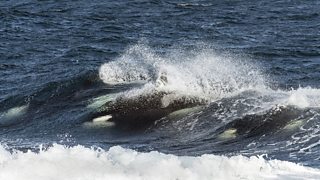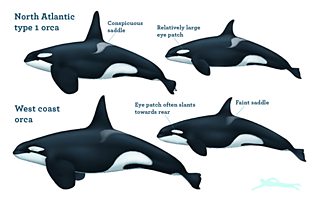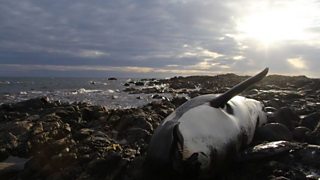
Orca, or killer whales are the largest members of the dolphin family. These enigmatic animals are apex predators, positioned right at the top of the food chain. No other animals hunt orcas except for humans.
They’re also the most widely distributed of all whales and dolphins and can be found in every single ocean, including waters around the UK. Your best chance of seeing them in the UK is around the Scottish coastline, where on a good day, they can be spotted right through the year. share recent sightings on their website and run an annual Orca Watch event inviting you to scan the seas of the Pentland Firth and log any orca you've seen. takes place between 23rd and 31st May.
In the UK, we have two different types of orca; each differs in its appearance, morphology and diet: the west coast community and the North Atlantic type 1 populations, which visit our waters from Norway and Iceland.

North Atlantic type 1 orcas
Most abundant is the North Atlantic type 1 orca, made up of lots of separate pods, these wide-ranging orca visit Scottish waters and tend to exhibit more generalist feeding behaviour following bony fish - herring and mackerel as well as predating seals, porpoises and birds.
Smaller than the west coast orcas, their average length is typically around 6.6m.
West coast orcas
The other community of orcas in UK waters are known as the west coast community.
They are thought to be specialist feeders of other marine mammals such as small minke whales, dolphins, porpoises and seals, which perhaps unsurprisingly has a direct effect on their size allowing them to reach impressive lengths of 8.5m.
But the story of the west coast population is a sad one. These ocean giants are on the very brink of extinction with officially just eight individuals left.
With just two males left, the population has been unable to expand and this is largely due to historical pollution from manmade chemicals known as polychlorinated biphenyls, or PCBs.

The danger of PCBs
PCBs were once used in the manufacture of industrial products such as transformers, cable insulation and some ship paints. Their manufacture was banned in the US and other countries during the 70s and 80s however levels in the environment have remained fairly constant.
Sadly, this has meant that PCBs have made their way into food chains and being the apex predators, orca have ingested and unwittingly stored these harmful toxins in their blubber, leading to poor health and disastrously, infertility.
When a mature female, Lulu, became entangled in fishing ropes and died in 2016 an autopsy revealed she had one of the highest levels of the man-made chemical ever recorded - more than 100 times above the level that scientists say will have biological consequences for a species. Dr Andrew Brownlow, head of the Scottish Marine Animal Stranding Scheme said,
"The levels of PCB contamination in Lulu were incredibly high, surprisingly so. They were 20 times higher than the safe level that we would expect for cetaceans to be able to manage.
"That puts her as one of the most contaminated animals on the planet in terms of PCB burden, and does raise serious questions for the long-term survivability of this group (of UK killer whales)."

Lulu's legacy
Although she was sexually mature, Lulu's necropsy showed she had never been pregnant. This finding, linked with the fact that no calves have been recorded in the west coast community since monitoring began in the early 80's, strongly predicts that this unique group of killer whales will become extinct in the coming years.
‘John Coe’ and ‘Aquarius’ are both very old and most likely in their final few years. John Coe was first observed in the early 1980s at which point he was already a mature adult. He’s roughly 57 years old and with adult male orcas usually living for 60 years, he’s sadly on borrowed time. Unfortunately there’s no hope for the continuation of this community because they are an isolated population with no other orcas of the same type within their range. The closest similar orcas are found in Antarctica. So every sighting of these two creatures is greeted with excitement, but at the same time great sadness. A double-edged sword of our own making.
These animals are typically seen off of the west coast of Scotland but are also seen off of Ireland, Wales and the East coast of Scotland. In June 2018 John Coe was spotted off Anglesey, Wales.
What can you do?
Every sighting of these two individuals, or any orca in UK waters is crucial – so if you are lucky enough to spot one, please report it via the
Become a beach clean organiser and
Take part in a anywhere, any time.
Consider these small changes to help our oceans
For more information about UK whales and dolphins, check out (Whale and Dolphin Conservation)
Andrea seeks therapy for her anxiety through orca-spotting
